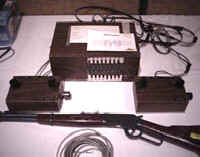|
|
Welcome to the nostalgic history of home and game computers
THE BEGINNING: THE MAGNAVOX
ODYSSEY
(Part 2 - click here
for Part 1)
 Baer began thinking about combining television
technique and gaming again only fifteen years later, in 1966. Meanwhile he
had climbed on the professional ladder; he had a leading function at
Sanders Associates in New Hampshire, a company for military electronics. Baer began thinking about combining television
technique and gaming again only fifteen years later, in 1966. Meanwhile he
had climbed on the professional ladder; he had a leading function at
Sanders Associates in New Hampshire, a company for military electronics.
Bus terminal
Baer: 'There were about 40 million TV sets in the USA
alone at that time. They were literally begging to be used for something
other than watching commercial television broadcasts!' One of those days,
waiting at a bus terminal, he wrote down some notes; within a week he
made, based on those notes, an elementary schematic for the projection of
two movable spots on a television screen. One of his important decisions
was to use the antenna input of the TV set to put the signal through and
to let the 'pictures' appear on channel 3 or 4; a decision that was
followed in almost the whole console and home computer industry.
 Fun Fun
Tangible result was a vacuum tube device in October
1966, a kind of chase game in which one player with his dot had to chase
the dot of the other player, and to try to touch it. Baer: 'It was
primitive, all right, but it WAS a video game, and it WAS fun.'
Although this little project had nothing to do with
military technique, Sanders Associates allowed him to go on. Even more,
Baer got a small team and some funds, although he had to spend most of his
time at his regular activities.
Brown Box
In 1967 the idea took shape to add a third
element to the screen: the ball. At the end of that year the prototype
appeared of the first working ping-pong game. The year after that Baer and
his assistants Bill Harrison and Bill Rusch improved the technique so that
several games could be played, with colours. Result was eventually the 'Brown
Box', the prototype of the Odyssey.
Pottering
Now the device was a technical success, it was
important to make it a commercial success, too. Pressure on Baer's team
increased because the patience at Sanders was wading. Many board members
believed that Baer was wasting his time with all this pottering. Baer
first thought about cooperating with cable companies. At the end of the
60s all those companies were in financial trouble, and Baer thought they
might use a fresh impulse. His idea was that a cable company provide the
games with coloured backgrounds, for example by sending a top view of a
tennis court, with stand, to the receiver of the consumer. But
negotiations failed.

Coincidence
Later, negotiations started with several television
set manufacturers. But only negotiations with RCA were serious, and after
months of talking they also failed. Coincidence paved the way to the
consumer market: an RCA-employee who was enthusiastic about the device
became a vice-president at Magnavox, were he succeeded to convince the
board to take another look at the Brown Box. With success: Magnavox decided
to take the box in production.
The prototype of the Odyssey at Magnavox was ready in
1971, and distribution started in 1972. Eventually some 100.000 Odysseys
were sold.
'Bad decision'
Baer has mixed feelings about the way and the form in
which his invention appeared on the consumer market. He considered it as
an 'excellent decision' that the switches on the original Brown Box were
replaced by 'cartridges', which saved the player from putting switches off
and on when choosing another game. But he called it a 'bad decision' that
Magnavox removed the possibilities for colour from the system and replaced
them by the overlays.
Magnavox televisions only
The fact that the first Odyssey never
became a big commercial success, is mainly caused by the bad marketing by
Magnavox. In commercials the company made consumers believe that the
Odyssey only functioned when plugged on TV sets from Magnavox. The game
system was only distributed through Magnavox dealers, and additional
cartridges that appeared later were put on almost invisible spots in the
stores. The worst thing in Baer's opinion is the price Magnavox asked:
$100. When he made his notes, waiting at the bus terminal, Baer wanted to
develop a game device with a retail price of about $20.
Tell a Friend
|
|
News |
 |
|
Play
games online on this site, and enter your name
and high score.
No need to download, play
Pac-Man, Space Invaders, Asteroids and Snake simply on the
screen.
Gameshop -
Atari, NES,
SNES and SEGA
games for sale

|
|
 |
 |
|

 Baer began thinking about combining television
technique and gaming again only fifteen years later, in 1966. Meanwhile he
had climbed on the professional ladder; he had a leading function at
Sanders Associates in New Hampshire, a company for military electronics.
Baer began thinking about combining television
technique and gaming again only fifteen years later, in 1966. Meanwhile he
had climbed on the professional ladder; he had a leading function at
Sanders Associates in New Hampshire, a company for military electronics. Fun
Fun

